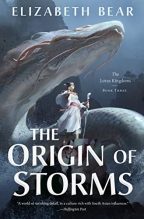 Locus: If I were a TV producer who wanted to take on an epic fantasy story à la Game of Thrones or Wheel of Time, I would look no further than Elizabeth Bear’s Lotus Kingdom books. To be honest, I’d much rather see an interpretation of Bear’s work over yet another Euro-based, medieval-esque retread of dudes fighting over who will be king.
Locus: If I were a TV producer who wanted to take on an epic fantasy story à la Game of Thrones or Wheel of Time, I would look no further than Elizabeth Bear’s Lotus Kingdom books. To be honest, I’d much rather see an interpretation of Bear’s work over yet another Euro-based, medieval-esque retread of dudes fighting over who will be king.
The Origin of Storms is a rich and satisfying conclusion to the trilogy, which began with The Stone in the Skull and The Red-Stained Wings. This trilogy is linked to and set in the same universe as Bear’s earlier Eternal Sky books – but these three titles make for a satisfying arc all on their own. If you want more in this world, however, there are three more books worth of epic goodness to pick from.
In the Lotus Kingdom arc, the driving question is about who will rule this loosely stitched-together amalgam of worlds that inhabit one planet, which makes more sense in context. The worldbuilding is Persian-influenced and deep. This is a place that feels lived in and that has texture.
The same is true for Bear’s characters. Despite this epic including a cast of dozens, each is three-dimensional and stands on his, her, or their own. Himadra could not be confused with his cousin and rival Mrithuri. Sayeh (perhaps my favorite) is an enduring source of wit and calculation. And then there’s the dragon, who is impossible to confuse with the mere mortals and who is also full of bleak wisdom. ‘‘’Life is pain,’ said the dragon. ‘Fortunately, it’s also very interesting.’’’
With The Origin of Storms, Bear lands this particular plane – and does it in such a way that questions our genre’s love of empire in fantasy epics while also tangibly demonstrating why readers still respond to them. Now it’s time for the same questions about empires and their rulers to bleed into other forms of pop culture.